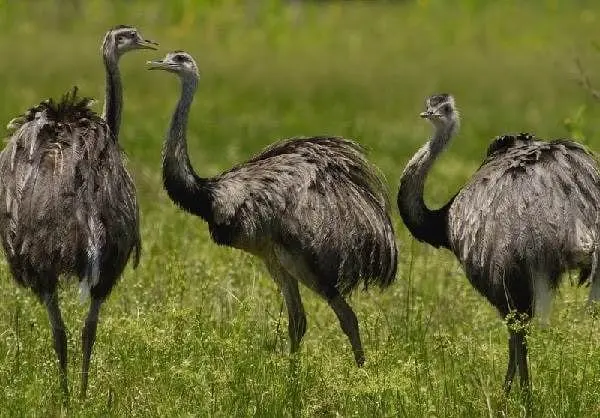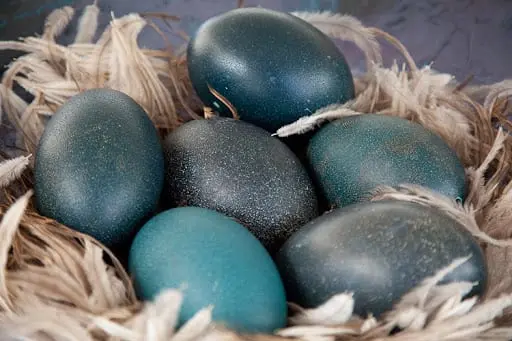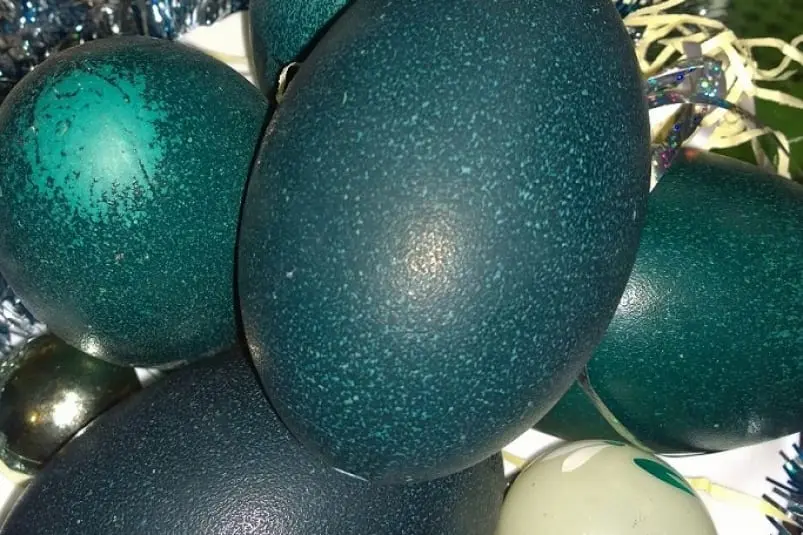Contents
Description of emu eggs
Emu egg is one of the largest on the planet (after the ostrich, of course). One such specimen can replace a whole tray of chicken eggs. But size isn’t the only thing that helps people to recognize this amazing food. Emu eggs are also one of the brightest on the planet – a rich green-blue hue allows the birds to mask future offspring in the grass.

The eggshell is composed of layers – usually from 7 to 12. Their color ranges from dark green on the outside to greenish-bluish in the middle and to an almost white of the inner layer. Each of the layers is not thicker than a sheet of paper.
They say that emu eggs taste good. And perhaps this is true. Otherwise, it would not have been so popular in the culinary world. Gourmets claim that its texture is more reminiscent of a duck egg than a chicken, although it is generally believed that emu and chicken eggs are almost identical in taste.
Description of the emu bird

Emu belongs to a family of flightless birds. Sometimes people call them Australian ostriches. And although outwardly there is some similarity between both birds, in fact, they are representatives of different families. Ostriches widespread in Africa belong to the Ostrich order. Emu is Cassowary and, by the way, the only representative of this family.
Their natural range in Australia, where these birds are as widespread as … chickens in Europe. Due to the estimations – between 625,000 and 725,000 of these flightless birds live on the mainland.
But if emus are so common, why are they so jealously protected by law? The fact is that these birds, which are relatives of some species of dinosaurs, are do not live anywhere else on the planet and are still under threat of extinction.

Emu sub-spieces
At one time, three species of birds were found on the Australian continent – emu (the one that inhabits the mainland today), black emu, and small emu. Representatives of the latter two species became extinct in the 19th century. Emu, despite their impressive size, tends to avoid people and other animals. They try to keep to the dense evergreen forests. Females are slightly larger than males, although smaller than African ostriches. They can reach 190 cm. high.
Interestingly, the emu has rudimentary wings about 20 cm long. Running (reaching speeds of up to 50 km / h), the birds flap them to maintain balance. During a walk, these birds’ stride length is about a meter, but while running, it can exceed 2.5 m. Unlike African ostriches, their legs are not two-fingered, but with three fingers, and in structure, they are more similar to those of other birds.
From a distance, the emus resemble a shock of hay; their brown plumage is long, shaggy, and like fur. But depending on the environment, the shade of the feathers can change.
Emu eggs composition
This delicacy in an emerald shell is an outstanding source of phosphorus, iron, B vitamins, folic acid, and B12, vitamins A and D. As for the lipid composition, this delicacy contains approximately 68% polyunsaturated fats (useful for humans) and 31 % saturated.
Besides, the composition contains 8 amino acids that are indispensable for humans (just like in a chicken product). Interestingly, the percentage of white and yolk is almost the same size, but the yolk is not as bright as in other birds.
Nutritional value per 100 grams:
- Protein, 14 g
- Fat, 13.5g
- Carbohydrates, 1.5 g
- Ash, 1.3 g
- Water, 74 gr
- Caloric content, 160 kcal
Shell use

To keep the shell intact as much as possible, the emu egg must be properly “opened.” To do this, it is advised to drill small holes at the ends of the egg and blow out the contents. Emu eggshells are an interesting material for decorative carving. It became popular among masters in the 19th century.
To understand how original products from this material look, it is enough to remember that the shell consists of several multi-colored layers. This feature allows crafters to create intricate patterns without additional paint. Artists create portraits, landscapes, miniature plots on eggshells, decorate them with beads, decoupage technique, and make small boxes.
And although emu eggs practically do not differ from chicken eggs in their chemical composition, many people adore omelets and other dishes from this exotic product. If you decide to cook for yourself something from such an unusual egg, remember: everything is good, that in moderation. But before you start cooking, do not forget to check the freshness of the product – at least visually and by smell.
Emu eggs contain a huge amount of nutrients similar to those found in chicken eggs. They are considered dietary foods because they are deficient in cholesterol.
It is in these eggs that the level of harmful substances is lower than in poultry eggs. This product is hypoallergenic, rich in trace elements and vitamins. Also, emu eggs contain polyunsaturated acids that help maintain the cardiovascular system.
Cooking use

Eggs are popular in cooking of various appetizers, casseroles and baked goods.
Using Emu eggs you can make make a wonderful snacks.
- To do this, boil the egg until tender, peel, and cut into rings. Each ring you should spread with a thin layer of butter layout like a cake on a plate and covered with mustard-cream sauce. A dish with the name “scramble” will become a decoration of every table.
2. First, you need to cut 150 g of ham into small slices and chop a bunch of green onions. Crush one and a half teaspoons of dill seeds in a mortar. Next, in a large bowl, you need to beat the emu egg and milk with 1 teaspoon of ground paprika, then add ham, green onions, dill seeds, and salt to taste. Coat the baking dish with butter and pour the resulting mixture into it. Please put it in an oven heated to 160 degrees. The cooking time is approximately 15-17 minutes.









